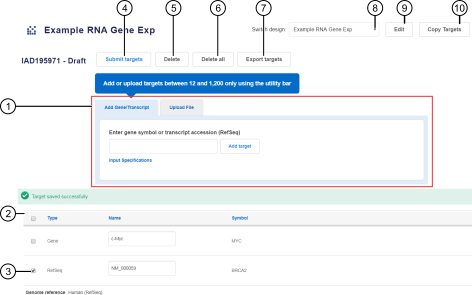Start a new Ion AmpliSeq™ RNA Gene Expression design
You can design a custom RNA Gene Expression panel to measure differential expression of genes of interest in your samples. RNA designs can include a valid HGNC gene symbols and RefSeq RNA accession numbers.
- In the home screen, in the Ion AmpliSeq™ Custom panels pane, click Create Custom panel.
- In the Start a new Ion AmpliSeq™ design screen, in the Name and details step, enter a design name and optional details.
-
In the
Application Type
step, click
RNA Gene Expression designs (single‑pool).
Selecting the application type filters the genomes to display only the selections that are compatible.
-
In the
Select genome to use
step, select Human (RefSeq).
IMPORTANT! RNA Gene Expression designs are only compatible with Human (RefSeq) genomes.
-
Click
Next: Add Targets.
A draft design screen opens (see Figure 1).
-
Add targets using the options available in
the target addition pane (see callout 1 in Figure 1).
For guidelines on how to add targets, see Ion AmpliSeq Custom panels: RNA Gene Expression design input specifications.
Option
Description
Add each target manually using a HGNC-approved gene symbols or a valid RefSeq transcript accession number.
-
In the Add Gene/Transcript tab, in the provided field, enter a gene symbol or a RefSeq transcript accession number. Alternatively, start typing the gene symbol or accession number, then select the gene or accession number from the dropdown list.
-
Click Add target after each entry.
If a target was added successfully, the Target saved successfully message appears. If a target accession number or symbol is invalid, the Target could not be saved error message appears. If needed, you can correct or update targets in the Name column the targets table (see step 7).
Upload multiple targets at one time using a CSV or Gene List (TXT) file.
 Figure 1. Draft design screen
Figure 1. Draft design screen
-
A target addition pane with multiple methods for adding targets to a design. Each tab contains fields that are specific to the corresponding target addition method.
-
Targets table lists all added targets in a design.
-
Select the checkbox in the row of each target that you want to delete.
-
Click to submit a design.
-
Click to delete the selected targets (see callout 3).
-
Click to delete all targets.
-
Click to export all targets to a CSV file.
-
Select from the dropdown list to display a different design.
-
Click to edit design name and details.
-
Click to copy targets to a new custom design.
The software uploads the targets, checks them, and verifies regions. The targets are added to the targets table (see callout 2 in Figure 1).
-
-
Review and modify the design as
needed.
Action
Description
Correct erroneous targets
Targets that contain errors are highlighted in red in the targets table. In the row of each erroneous target, modify the gene symbol or transcript accession number in the Name column.
Delete targets
In the targets table, select the checkbox in the row of one or more targets, then click Delete. To delete all targets, click Delete all. See callouts 3, 5, and 6 in Figure 1.
Export targets to a CSV file
Click Export targets. A CSV file that contains the list of all added targets is automatically downloaded to your local storage (see callout 7 in Figure 1).
Edit design name and details
Click Edit, then in the Edit your design screen, modify design name and details as needed. Click Save. See callout 9 in Figure 1.
Copy targets to a new design
Click Copy Targets, then in the Copy Design dialog, select the panel type and DNA type, and enter the name and details for the new design. Click Save. See callout 10 in Figure 1.
The new design is added to the list of your custom designs. To view or edit the new design, click in the navigation bar. Alternatively, open a new design by selecting a design from the Switch design dropdown list (see callout 8 in Figure 1). For designs that have been submitted, or locked, the design opens to the Results ready screen.
-
To submit your panel, click
Submit targets,
then click
OK to
confirm your submission (see callout 4 in Figure 1).
Up to 5 designs can be submitted at one time.
After submission, a submitted design screen opens, displaying the design confirmation message.
After you submit your design, the targets are locked ( ) and can no longer be edited.
When the assay design results are ready, you receive an e‑mail notification
instructing you to review the results in Ion AmpliSeq™ Designer. Click the
View results
link provided in the email to be directed to the results page. Alternatively, sign
in to Ion AmpliSeq™ Designer (AmpliSeq.com), then in the navigation bar
click to access the results for your design (see My Designs).
) and can no longer be edited.
When the assay design results are ready, you receive an e‑mail notification
instructing you to review the results in Ion AmpliSeq™ Designer. Click the
View results
link provided in the email to be directed to the results page. Alternatively, sign
in to Ion AmpliSeq™ Designer (AmpliSeq.com), then in the navigation bar
click to access the results for your design (see My Designs).
To review design details and place an order, proceed to Order an Ion AmpliSeq custom panel.
